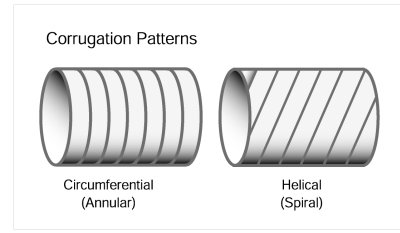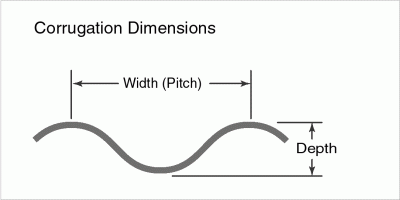Corrugations |
Corrugations are the undulations present in corrugated metal pipes (CMP) and structural steel plate pipes (SSP). As a Culvert Material, corrugations are added to culverts to add stiffness and increase structural strength. They have also been found to provide holding areas for juvenile fish at low flows by adding surface roughness which increases over the width and depth of standard dimensions. Corrugations can be formed in a circumferential (annular) pattern or run in a helical pattern (spiral) around the pipe. Helical corrugations tend to reduce the roughness by increasing hydraulic efficiency of flow through the pipe.

Corrugations are measured and categorized by the depth and spacing. Most CMPs under 60 inches in diameter have 2 2/3-inch x 1/2-inch corrugations. CMP greater than or equal to 60 inches in diameter typically have 3-inch x 1-inch corrugations. Structural plate pipes (SPP) and structural plate pipe arches (SPPA) often have 6-inch x 2-inch corrugations. The size of the corrugations determines the culvert roughness used in FishXing. Corrugations are measured from crest to crest (width) and valley to crest (depth).

Descriptions of different culvert materials that can be selected in FishXing :
|
Construction |
Description |
|
CMP (2 2/3- X ½-inch corrugation) |
Galvanized steel or aluminum with ½ inch high corrugations, spaced 2 2/3 inches apart. |
|
CMP (3- X 1-inch corrugations) |
Galvanized steel or aluminum with 1 inch high corrugations, spaced 3 inches apart |
|
CMP (5- X 1- inch corrugations) |
Galvanized steel or aluminum with 1 inch high corrugations, spaced 5 inches apart |
|
SSP (6- X 2- inch corrugations) |
Galvanized steel plates bolted together, with 2 inch high corrugations, spaced 6 inches apart |
|
Spiral CMP |
Galvanized steel or aluminum with helical corrugations, typically ½ -inch high, spaced 2 2/3-inches apart |
|
Concrete
|
Rough concrete associated most often with box culverts |
|
PVC |
Plastic with varied corrugation sizes |